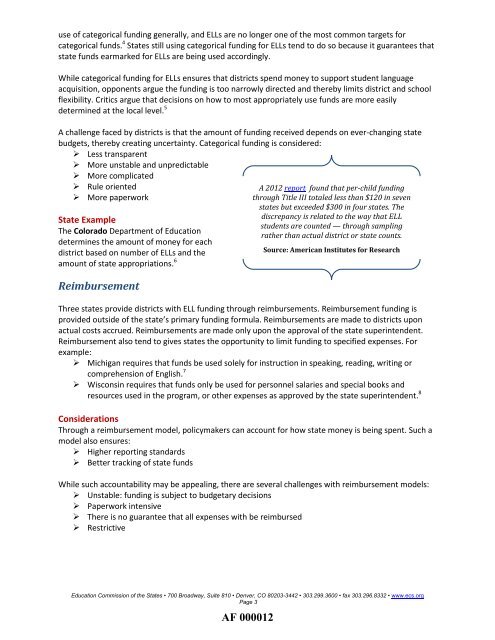11-30-Electronic-Cover-letter-and-Report
11-30-Electronic-Cover-letter-and-Report
11-30-Electronic-Cover-letter-and-Report
You also want an ePaper? Increase the reach of your titles
YUMPU automatically turns print PDFs into web optimized ePapers that Google loves.
use of categorical funding generally, <strong>and</strong> ELLs are no longer one of the most common targets for<br />
categorical funds. 4 States still using categorical funding for ELLs tend to do so because it guarantees that<br />
state funds earmarked for ELLs are being used accordingly.<br />
While categorical funding for ELLs ensures that districts spend money to support student language<br />
acquisition, opponents argue the funding is too narrowly directed <strong>and</strong> thereby limits district <strong>and</strong> school<br />
flexibility. Critics argue that decisions on how to most appropriately use funds are more easily<br />
determined at the local level. 5<br />
A challenge faced by districts is that the amount of funding received depends on ever-changing state<br />
budgets, thereby creating uncertainty. Categorical funding is considered:<br />
Less transparent<br />
More unstable <strong>and</strong> unpredictable<br />
More complicated<br />
Rule oriented<br />
A 2012 report found that per-child funding<br />
More paperwork<br />
through Title III totaled less than $120 in seven<br />
states but exceeded $<strong>30</strong>0 in four states. The<br />
State Example<br />
discrepancy is related to the way that ELL<br />
students are counted — through sampling<br />
The Colorado Department of Education<br />
rather than actual district or state counts.<br />
determines the amount of money for each<br />
district based on number of ELLs <strong>and</strong> the<br />
Source: American Institutes for Research<br />
amount of state appropriations. 6<br />
Reimbursement<br />
Three states provide districts with ELL funding through reimbursements. Reimbursement funding is<br />
provided:outside:of:the:state’s:primary:funding:formula:Reimbursements:are:made:to:districts:upon:<br />
actual costs accrued. Reimbursements are made only upon the approval of the state superintendent.<br />
Reimbursement also tend to gives states the opportunity to limit funding to specified expenses. For<br />
example:<br />
Michigan requires that funds be used solely for instruction in speaking, reading, writing or<br />
comprehension of English. 7<br />
Wisconsin requires that funds only be used for personnel salaries <strong>and</strong> special books <strong>and</strong><br />
resources used in the program, or other expenses as approved by the state superintendent. 8<br />
Considerations<br />
Through a reimbursement model, policymakers can account for how state money is being spent. Such a<br />
model also ensures:<br />
Higher reporting st<strong>and</strong>ards<br />
Better tracking of state funds<br />
While such accountability may be appealing, there are several challenges with reimbursement models:<br />
Unstable: funding is subject to budgetary decisions<br />
Paperwork intensive<br />
There is no guarantee that all expenses with be reimbursed<br />
Restrictive<br />
Education Commission of the States • 700 Broadway, Suite 810 • Denver, CO 80203-3442 • <strong>30</strong>3.299.3600 • fax <strong>30</strong>3.296.8332 • www.ecs.org<br />
Page 3<br />
AF 000012


